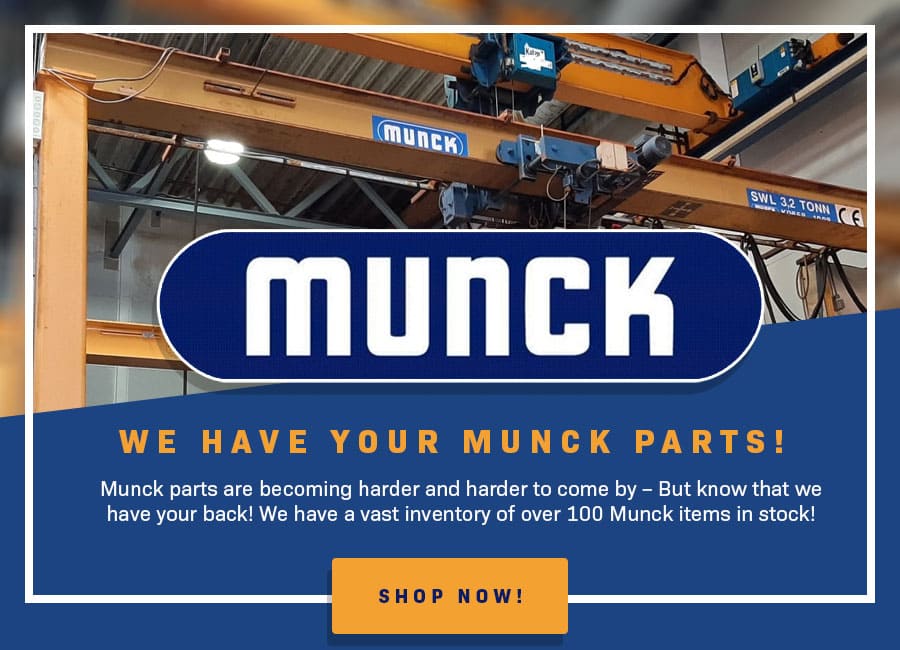Overhead Crane vs. Hoist
Both overhead cranes and hoists are machines used to move heavy or bulky materials and equipment around industrial and commercial job sites. While some people incorrectly use the terms interchangeably due to their similarities in function, they remain distinct machines due to their many differences in design and use. For example, hoists move loads up and down, while cranes move loads up and down and side to side.
Below, we provide a more comprehensive overview of overhead cranes and hoists, discussing what they are, how they operate, and how the two types of lifting equipment differ.
An Overview of Overhead Cranes
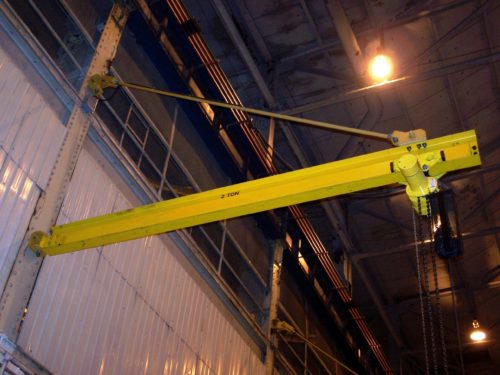 An overhead crane is a piece of equipment that securely lifts and lowers heavy loads along a vertical axis and moves them along other axes. This quality allows for multi-directional mobility in a worksite. For example, a construction worker can use an overhead crane system to pick up a load at one area of the construction site, move the load along a fixed rail system to position it above another area of the construction site, and set the load down at the new area.
An overhead crane is a piece of equipment that securely lifts and lowers heavy loads along a vertical axis and moves them along other axes. This quality allows for multi-directional mobility in a worksite. For example, a construction worker can use an overhead crane system to pick up a load at one area of the construction site, move the load along a fixed rail system to position it above another area of the construction site, and set the load down at the new area.
Components of an Overhead Crane
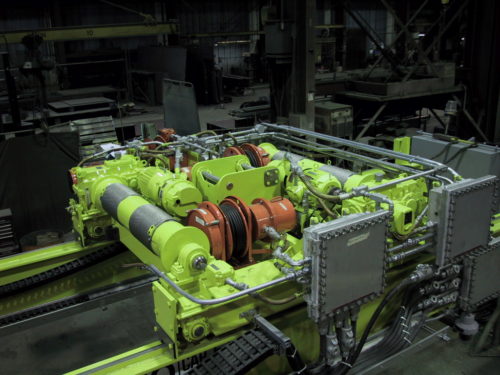 Overhead cranes consist of three main components:
Overhead cranes consist of three main components:
- The hoist: This part controls the vertical lifting and lowering. It is fixed to the trolley component, which allows it to move back and forth across the bridge as needed. Its load capacity depends on its design and construction. For example, chain hoists are suitable for loads of 5 tons and below, while wire rope hoists are suitable for loads of 5 tons and above.
- The trolley: This part moves the hoist along the bridge. It is available in three main types, each of which offers different advantages in different applications. Low headroom trolleys feature a compact design that makes them suitable for single-girder crane applications, normal headroom trolleys are suitable for monorail and jib crane applications, and double-girder trolleys provide superior clearance and headroom for double girder-crane applications.
- The bridge: This part serves as the component on which the trolley moves back and forth.
Types of Overhead Cranes
While all overhead cranes operate under the same basic design principles, they are available in multiple variations to suit different work environments. The most common types include:
- Top running cranes: In top running cranes, the bridge components move atop ceiling-mounted rails. This crane design is well-suited for lifting and moving heavy loads.
- Under running cranes: In under running cranes, the bridge components move along the bottom of ceiling-mounted rails.
- Gantry cranes: In gantry cranes, the bridge component is not attached to the ceiling. Instead, a single or double girder is attached to wheeled legs. This crane design is popular in shipbuilding applications.
- Monorail cranes: In monorail cranes, the trolley-mounted hoist moves along a single, circular, oval, or winding path throughout the facility. This crane design is suitable for moving loads within tight or complex spaces.
An Overview of Hoists
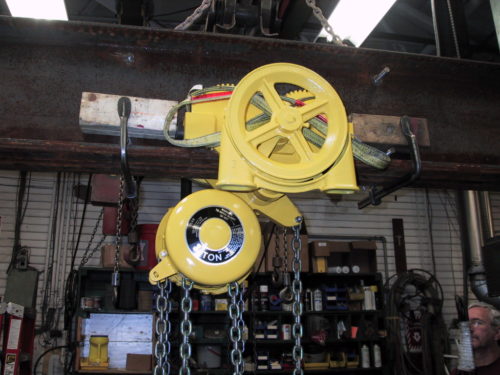 Unlike overhead cranes, hoists only provide vertical movement (i.e., lifting and lowering of loads). They do not provide any horizontal moving action to loads except when used as the lifting component of larger lifting systems (e.g., overhead cranes). One common example is an elevator.
Unlike overhead cranes, hoists only provide vertical movement (i.e., lifting and lowering of loads). They do not provide any horizontal moving action to loads except when used as the lifting component of larger lifting systems (e.g., overhead cranes). One common example is an elevator.
Design Considerations for Hoists
Despite their limited directional mobility, hoists are still commonly used as lifting equipment for various heavy materials and equipment. The type employed varies from application to application, depending on the lifting requirements. Some of the design factors to consider include:
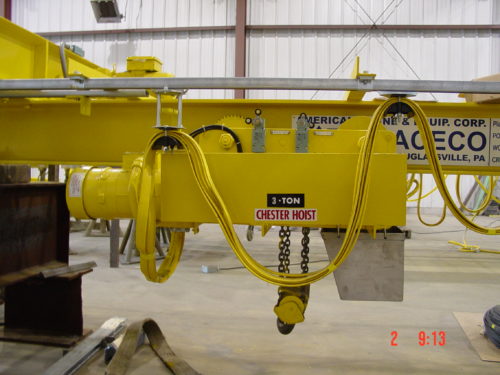 Lifting medium: The lifting medium is the material used to connect the load hook (i.e., the component securing the load) to the body of the hoist. The type used in a hoist system depends on the expected weight of the load(s). It can be rope, metal cable, roller load chain, or welded link chain.
Lifting medium: The lifting medium is the material used to connect the load hook (i.e., the component securing the load) to the body of the hoist. The type used in a hoist system depends on the expected weight of the load(s). It can be rope, metal cable, roller load chain, or welded link chain.- Power: The power refers to how the hoist is powered. It can be a manual mechanism (e.g., a pulley used to multiply the pulling force input by the operator), an electrical mechanism (e.g., an electrical motor), or a pneumatic mechanism (e.g., an air-powered motor). The type used in a hoist system depends on the lifting/lowering force required and the existing setup of the facility. For example, facilities that already use air tools may find pneumatically powered hoists easier to integrate.
- Suspension: The suspension refers to the mounting method of the hoist. Some of the most common are hook-mounted, lug-mounted, and trolley-mounted. The type used in a hoist system depends on the lifting requirements. For example, hook-mounted hoists are used for lifting applications that only require moving the load up and down, while trolley-mounted hoists are used for lifting applications that require moving the load up and down and to different areas of a worksite.
Main Differences Between Overhead Cranes and Hoists
There are many differences between overhead cranes and hoists. The main one is their range of movement. Hoists can only move loads up and down, while cranes can move loads up and down and side to side. In the latter, a hoist serves as the component that provides vertical movement, while a trolley and bridge serve as the components that enable horizontal movement.
The other main difference between overhead cranes and hoists is how they are categorized. Overhead cranes are generally grouped by their design and construction (e.g., top running, under running, gantry, and monorail), while hoists are typically classified by their lifting medium, power type, and suspension.
Overhead Cranes and Hoists From American Crane
While overhead cranes and hoists differ in design and purpose, both pieces of equipment are valuable tools in moving heavy and bulky loads in industrial and commercial worksites. However, it is essential to choose one that is well-suited for your application. If you need help selecting and sourcing overhead cranes or hoists for your facility, ACECO is your expert, craftsman, and partner.
At American Crane & Equipment Corporation, we offer standard and custom material handling equipment—including hoists and overhead cranes—for a wide range of applications. For additional information about our products and services or assistance choosing a lifting equipment solution for your facility, contact us or request a quote today.





